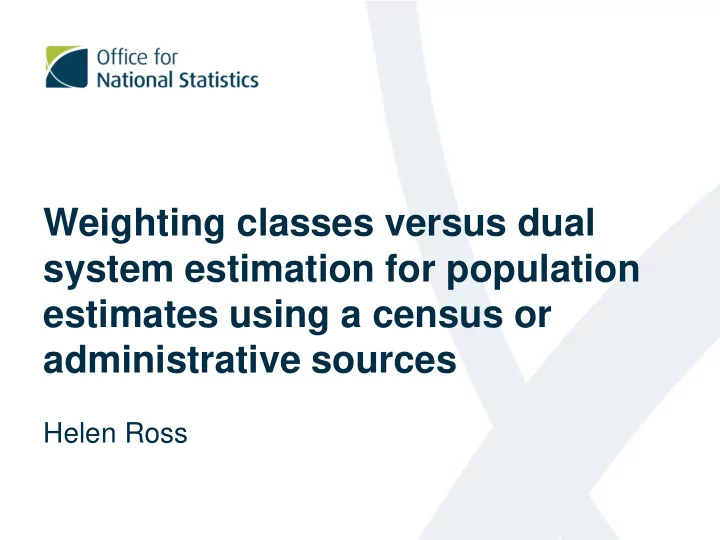

Weighting classes versus dual system estimation for population estimates using a census or administrative sources Helen Ross
Framework for producing population estimates using a census Coverage Survey Census Estimation Estimates
Framework for producing population estimates using administrative data Admin datasets A Coverage Survey Statistical Matching Rules Population B Datasets (SPDs) C STAGE 5 STAGE 5 Estimation Estimates
Dual system estimation Census Coverage Survey Counted Missed Total Counted n 11 n 10 n 1+ Census Missed n 01 n 00 n 0+ Total n +1 n +0 n ++
Advantages and disadvantages • Widely used and well understood • Robust to small violations in assumptions • Susceptible to biases when assumptions are violated • High quality individual level matching required • Requires adjustments to mitigate against biases
Weighting class estimation • Partitioning of data into classes • Linking of addresses between the survey and the census (or SPD) • Calculation of response probability using information about survey responding and non-responding households
Advantages and disadvantages • Individual level matching not required • Less susceptible to overcoverage • Does not adjust for within household non- response • Requires high quality address frame
Simulation studies Relative bias for total population estimates Scenario Method Base with no Base within hh NR Truth 0.03% - Dual system estimation 0.31% - Age-sex weighting class estimation -2.96% -0.07%
Simulation studies 3.0% Base - DSE 2.0% 1.0% Relative bias 0.0% No within hh nr - WCE -1.0% -2.0% -3.0% -4.0% Base - WCE -5.0% -6.0%
Summary • Weighting class estimation is a plausible alternative to dual system estimation • Both require a set of underlying assumptions • Weighting class estimation is less well understood in this context • Further work to explore both before any decisions are made
Recommend
More recommend